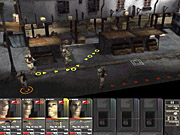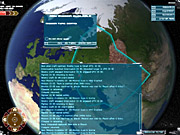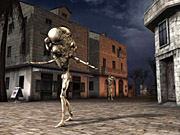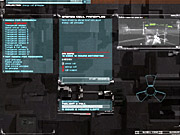UFO: Aftermath Q&A
We speak with Altar's Jiri Rydl to get the latest word on the game that's been called the spiritual successor to the classic turn-based tactical game, X-COM.
In the years following the success of Microprose's X-COM: UFO Defense, turn-based tactical games were all the rage. But while there've been a couple of good tactical strategy games in recent years, as often as not they've adopted fast-paced real-time mechanics. Now, nearly 10 years after X-COM's release, an upcoming game from Altar Interactive, UFO: Aftermath, promises to pay homage to the X-COM legacy and bring it up to date with 3D graphics.
UFO: Aftermath itself has had a convoluted history, having started its life as Dreamland Chronicles: Freedom Ridge, which was initially being developed by some of X-COM's creators at Mythos Games. The Czech studio Altar Interactive has long since taken over the project, and it has just clinched a new publishing deal with Cenega Publishing to ensure smooth distribution for the game. We've spoken with Altar Interactive's Jiri Rydl to get the latest word on the project's progress.
GameSpot: It's been a while since we last spoke about UFO: Aftermath. How has development been coming along?
Jiri Rydl: Earlier this year, Titus decided to concentrate more on next-generation console titles, so we were in the process of finding a new publisher for UFO: Aftermath between E3 and ECTS, which has caused a little delay in development. However, we're past that now.
GS: Altar just secured a new publishing deal for the game. Who is it with, and how long has it been in the works?
JR: Just a few hours ago, we signed a deal with Cenega Publishing. We are back on track, with our ETA pushed back to the middle of 2003.
GS: Are there plans to release the game simultaneously in Europe and the US, or will it be distributed first in one region?
JR: A US distribution partner hasn't been set up yet, but we, together with our publisher, plan to release UFO: Aftermath at the same time in USA and Europe. More details will be revealed soon.
GS: UFO is the first game in a while to adopt turn-based tactical squad mechanics. How have you worked to continue the legacy of the X-COM games?

JR: Instead of aping X-COM, we've focused on implementing changes that, in our opinion, increase the playability and value of the game for today's players. One of these changes, which has been extensively discussed at our official UFO: Aftermath forums, is implementing the simultaneous assault system (SAS).
We're developing a squad-based tactical game, so we've also decided to reduce the number of activities for the player. That doesn't mean we've simplified the game, however, as we still offer many important strategic decisions on planetary level, which will affect the squad vs. aliens combat and vice versa.
We want to develop a game that's at the top of its genre. With multiple winning strategies, a huge number of guns and technologies, many alien artifacts to research, an interesting story, and a constantly changing 3D environment, we think that we have accomplished that.
GS: UFO: Aftermath has had an interesting history. Tell us a little about the game's early development. What changes were made to the Dreamland Chronicles game that Mythos originally started once Altar took the project over?
JR: The recent history of UFO: Aftermath begins when we finished our previous title, Original War, for Virgin Interactive. We had several ideas about what sort of game we could do next, but then Paul Whipp from Virgin offered us a chance continue the development of Dreamland Chronicles: Freedom Ridge, which had been previously developed by Mythos Games, the makers of the first X-COM games.
Shortly after we started, we realized that we would have to start from scratch. While we were at it, we included some changes to reflect our point of view on tactical sci-fi games.
There are two main innovative features we are proud of. One is the SAS, which I've mentioned, and the second is our in-house engine, which is capable of randomly generating missions in full 3D.
GS: The game takes place after aliens have invaded Earth. Give us a little more detail on the story. 
JR: The day after tomorrow, a giant spacecraft approaches Earth. Silent, it hovers ominously over the world and begins to release great clouds of spores into the upper atmosphere. Rapidly multiplying, the spores soon darken the skies, and before long obscure the sun completely. In later days, this period will be known as the "Twilight." Having reached critical mass in the skies, the spores begin to rain down, and over the course of several days, they begin to clog the streets and bodies of water, smothering people in their homes and burying animals in the wild. During the "Nightfall," as it would come to be called, most of the higher life-forms on the earth were wiped out.
During the Twilight, all human responses were futile. Choosing caution over aggression, the governments of the world didn't realize how quickly the end could come and were buried alongside the people they governed. A few, however, did survive, sealed in underground bases with stocks of food and oxygen. After several weeks, the spores seemed to have disintegrated, decomposing and settling into the soil. The world seemed safe again, for a time. This is where you come in: You must gather together the remaining peoples of the planet, find out what has happened, and, if possible, get your revenge.
GS: There's more to the game than tactical squad combat. How would you describe the final mix of gameplay elements?
JR: The strategic game is very important to your progress in the game overall, because every decision made there could ruin the fragile balance between the attackers and your troops. Once you make your decisions there, however, you will have to fight the alien threat on the ground. We think that players will spend around 60 to 80 percent of their time in tactical missions.
GS: How has the gameplay evolved over the course of the game's development?
JR: We are still working on it. We are focusing on the tactical combat, but the story is also very important. Without any research into the aliens' technology, you won't progress much and you'll quickly be squashed by the growing power of the enemy forces.
GS: Tell us how a combat sequence will play out in the game.
JR: Tactical missions use our already spoken of combat system, which features all the best elements of both turn-based and real-time combat systems. You give orders while the game is paused, to avoid the frantic rush of a real-time system. While paused, you can give your troops very detailed orders, taking as much time as you like. Once you are finished, you simply tell the game to start. Once the game is under way, you can pause it at any point to update or change your orders, and the game will automatically pause when important events occur so you may modify your plans accordingly. Be sure to note that all the combat happens at once, combining the deep tactics of a turn-based game with the realism of a real-time system.

GS: How does the strategic portion of the game work?
JR: In the strategic portion of the game, you must manage your bases, interceptions, and squads. Also important to the strategic portion of the game is the "biomass," a slimy, tangled mass creeping slowly across the whole of the world. Territory is equal to power in the game--the more you control, the better your interceptor coverage, the faster you can do research, and the more biomass you can repulse. You gain territory by engaging in tactical missions, where your squads must engage the aliens and mutants face-to-face. Once you control a territory, you can decide what type of base you want there: research, military, or biomass repulsion. Each kind of base has a noticeable effect on the overall capabilities of your forces.
GS: What friendly units are available to players? Is there an element of character development that will let players improve their units' skills over the course of the game?
JR: I would rather not comment on friendly units at this point. The enemies are more interesting: horribly mutated creatures, originally from Earth, and, of course, the aliens. The aliens look small and weak, but their technology level is much higher than ours. Players won't live too long with just the basic guns.
As for the second question, all your troops have names, portraits, and sets of statistics. Their skills are derived from these statistics, and each point that you put into any one of these attributes will have a noticeable effect on those soldiers' skills. With enough experience, you can easily make your soldiers into whatever you want them to be, either generalists or specialists. You can make snipers, medics, heavy weapons soldiers, or any mix of all these skills and more. It is very important that you do so, in fact, as a group of random, average soldiers who are good at everything and excellent at nothing will get chewed up as the opponents become tougher. You need to create a solid team with a good group of interlocking skills to win.
GS: What will the game's locations and environments be like? Does it take place primarily on Earth?
JR: A variety of geographical locations are represented. A fight could take place in a city, the jungle, the desert, the mountains, and the bush, or at a base. For instance, cities in Eastern Europe will prominently feature the big, gray concrete buildings that dominate the city outskirts here.
GS: Tell us about the game's graphics.

JR: We are very glad we have Tomas Kucerovsky on our team. Terrible creatures and dark gloomy missions have been created under his careful guidance. That's the assurance that the fights will take place in quality postapocalyptic environments, full of empty buildings, dead bodies, and the detritus of an entire civilization.
From a technical point of view, the engine supports multitexturing, skinning, animation blending, dynamic lights, gamma correction, and the standard host of features expected of a modern graphics engine. Our programmers are still working on it, of course, so the list of features will only grow. The engine also supports weather effects like rain and snow, day and night missions, destructible environments, and dynamic audio with 3D positioning.
GS: Is there any multiplayer support planned for the game?
JR: UFO: Aftermath is strictly a single-player game.
GS: What element of UFO: Aftermath are you most excited about?
JR: I am personally a big fan of strategy games, including Jagged Alliance, X-COM, Fallout Tactics, and lately Freedom Force, so I am excited about the game as a whole. I am especially looking forward to kicking some alien butt.
GS: Is there anything else you'd like to say about the game?
JR: Join other fans at www.ufo-aftermath.com. We are always eager to hear your opinions about the game.
GS: Thanks for your time, Jiri.
Got a news tip or want to contact us directly? Email news@gamespot.com
Join the conversation